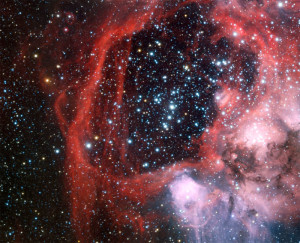What Is The Large Magellanic Cloud
The Large Magellanic Cloud (LMC) isn’t a cloud at all – it’s actually one of several dwarf galaxies that orbit a short distance from the Milky Way. When we say a ‘short’ distance, we mean astronomically short: it’s roughly 160,000 light years from Earth and it’s not that ‘dwarf’ either. At 14,000 light years in diameter, it comes to about one per cent the mass of our own galaxy.
As you might expect, all that makes the LMC a fairly easy celestial subject to spot in the cosmos. But to create this image – the sharpest and most accurate shot of this galaxy to date – NASA’s orbiting Spitzer Space Telescope had to go to great lengths. It’s captured in infrared and made up of 300,000 individual tiles, using a process that was 1,000 times more sensitive than techniques used in previous missions, which accounts for the super-high degree of detail seen in the final image.
About a million previously unseen objects were discovered in the Large Magellanic Cloud as a result. The blue glow from the centre of the galaxy is light from older stars, while massive hot stars surrounded by dust from their own coronal ejections appear as bright white-blue spots. The red dots are either ancient stars or distant galaxies, while the greenish-yellow represents relatively cool interstellar gas.
 This is much more than just a pretty poster though: astronomers were able to use this composite to quantify how space dust is recycled into stars, then star systems and, ultimately, back into dust again. In this image, you can see space dust being expelled by old stars around the red dots, spread about in the greenish-yellow clouds and being consumed by young stars in the rust-toned clouds.
This is much more than just a pretty poster though: astronomers were able to use this composite to quantify how space dust is recycled into stars, then star systems and, ultimately, back into dust again. In this image, you can see space dust being expelled by old stars around the red dots, spread about in the greenish-yellow clouds and being consumed by young stars in the rust-toned clouds.
The Magellanic family
The LMC has a smaller twin called the Small Magellanic Cloud (SMC). At 7,000 light years in diameter, it’s around half the size of its bigger sibling and has the equivalent of about two-thirds of the LMC’s mass, at 7 billion solar masses.
The two are paired and are in relatively close proximity with each other, the SMC being 200,000 light years from Earth and one of the farthest objects we can see with the naked eye. However, it can only be seen in the southern hemisphere and, because it’s very faint, only clearly in areas of very low light pollution, such as the Australian desert and the site of the Very Large Telescope (VLT) in the Chilean Atacama Desert.
Some astrophysicists think there might be an even smaller section behind (from our perspective on Earth) the main body of the SMC galaxy, separated by 30,000 or so light years. They’ve nicknamed this the Mini Magellanic Cloud (MMC).
